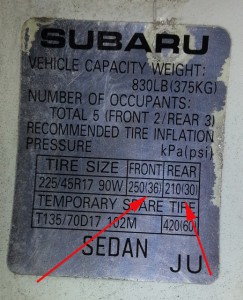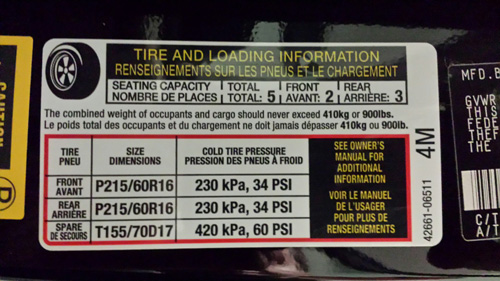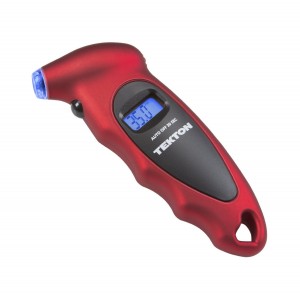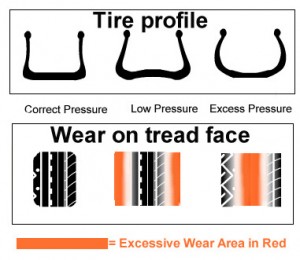And, now for something non-dental. But, it may save dental lives. I just came in from the garage after rotating my tires and adjusting their pressures.
 The number ONE safety device on your car isn’t your seat belt, air bags, or anti-lock brakes. It is your TIRES. It’s very important to have your tires inflated to the correct pressure. It’s critical! I’m amazed at how often I see people driving with a tire that is obviously under-inflated…. even FLAT.
The number ONE safety device on your car isn’t your seat belt, air bags, or anti-lock brakes. It is your TIRES. It’s very important to have your tires inflated to the correct pressure. It’s critical! I’m amazed at how often I see people driving with a tire that is obviously under-inflated…. even FLAT.
Keep in mind the correct pressure is NOT what is printed on the side of the tire. The correct pressures are printed on a metal placard or sticker, typically on the door-jamb on the driver’s side. Open the drivers door and look near where the door-latch is on the car body. You’ll see something like this:

Notice that for this car, the pressures are different for the front vs rear tires.
Notice (red arrows) that the front and rear pressures may be different. You’ll also see that it may be listed in both metric and English units: 250 kPA (36 PSI). Your pressure gauge (you own one, right?) is likely calibrated in English Pounds per Square Inch (PSI). You can see that my car requires 36 PSI in the front tires and 30 PSI in the back tires.
Another example:

In this case, the tire pressures happen to be the same for front and rear tires. Notice the correct pressure for the spare tire is also specified.
Tires lose pressure over time, even when they are intact. You should periodically check their pressures and top them off. Ideally, you should do this about once a month. If you live in northern states, the cold winter weather will also decrease the tire pressure.

Digital tire pressure gauges like this one are easy to read and inexpensive… about $10 (or less). Keep one in the glove box of each car. You should never “eyeball” a tire for proper inflation.
The only things that keep your car under control are the four tire “contact patches.” Think about it…. they are about 6 – 8 inches square. So, you might have a mere 256 square inches of rubber that controls your 3,500 – 6,000 lb vehicle. Or, if you think of it as a single 16-inch square patch of rubber (256 sq. in.), it makes visualization even easier (and more frightening).
Your car accelerates, decelerates (slow down), turns, and stops… ALL via the tires contact patches. Your tires are the link between the road and all of your car’s controls. If your tires are compromised in any way, your ability to turn, accelerate, and stop will ALL be compromised.
The proper, manufacturer-recommended pressures create ideal contact patches for your vehicle. This is often based on the weight and weight distribution of your vehicle. That’s why on my car, the front pressures are different than the rear pressures. If the tires are over or under-inflated, the contact patch will not be ideal, and you will get less traction.
Another reason for the recommended pressures is that it allows the tires to wear ideally. If they are under-inflated, the inside and outside edges of the tire tread will wear more quickly. If the tires are over-inflated, the center of the treads will wear more quickly. Either situation is DANGEROUS, especially in wet or slippery conditions.

So, please check your tire pressures regularly. You should also rotate your tires about every 5,000 miles… or each time you change your oil. Remember that if you rotate the tires, the correct pressure may have changed (front vs. back).
And, when you buy new tires for your vehicle, don’t cheap out! Just like dentists, not all tires are created equal! The safety of your family depends on it!
PS… Don’t forget to check the pressure of your spare tire! This is often neglected, only to find out at the worst possible time (when you have a flat)… that your spare is flat, too!
 Copyright protected by Digiprove © 2013 The Dental Warrior®
Copyright protected by Digiprove © 2013 The Dental Warrior® 
Tire rotation is also important. When changing tires, always put the new tires at rear. Good tips!
Ideally, if you’ve been rotating, they should all wear out at the same time. But, if you only replace two of them, I believe where you put them (front vs. back) may depend on whether your car is FWD or RWD.